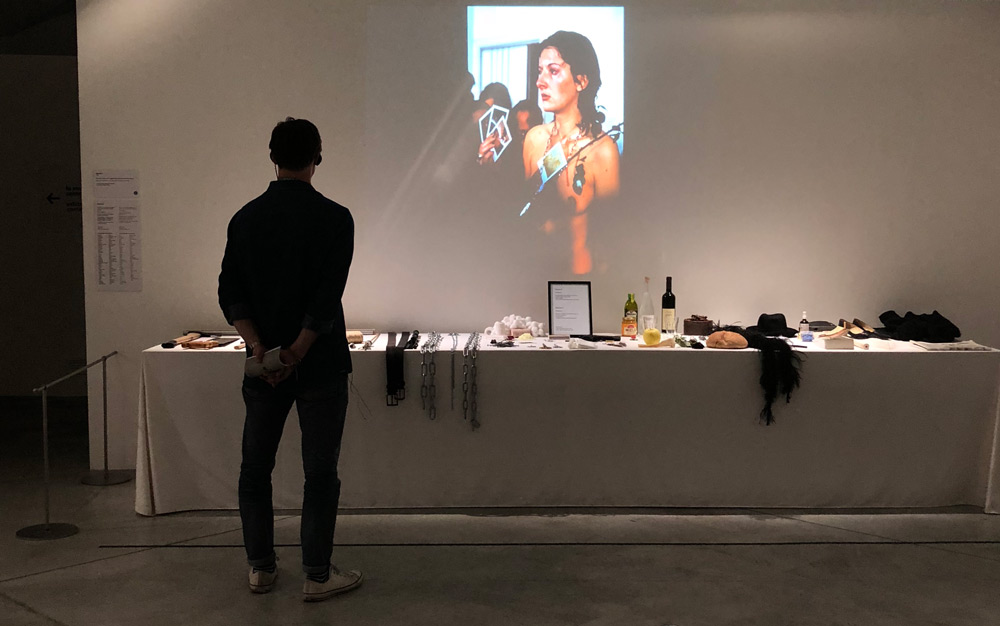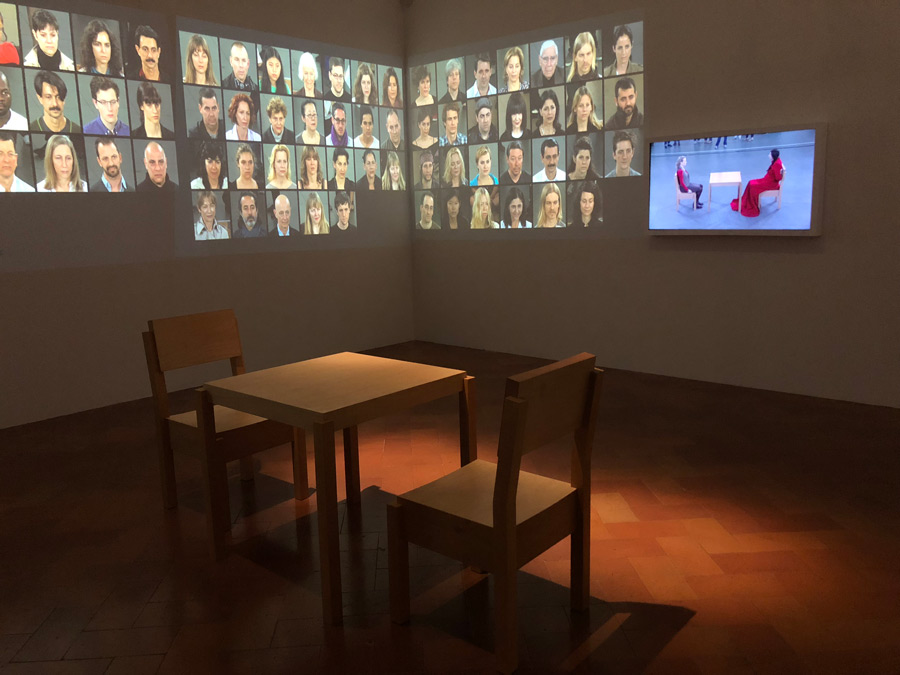
Palazzo Strozzi, Florence
September 21, 2018 – January 20, 2019
The process is more important than the result
By Marie-Claire Desjardin (Istituto Lorenzo de’ Medici)
Palazzo Strozzi Foundation presents the first female solo exhibition in their institution, a retrospective of Marina Abramović entitled The Cleaner. Throughout the exploration of Abramović’s five decade long career, the exhibition addresses the issue of the impermanence of performance art, and how to conserve works dependent on the ‘here and now’. Abramović has explored the temporal restraints of her chosen medium in previous retrospectives in the United States, and continues the narrative at Palazzo Strozzi.
‘Reperfomances’ play a key role in the exhibition. Throughout the day a team of performance artists, trained in the strict Abramović method taught in coordination with the artist’s foundation MAI, rotate several of her most recognizable works. The fleeting nature of Performance Art presents an unusual dilemma for a retrospective as the medium itself is transitory. Although the original energy and the artist’s charismatic dedication to her craft could never be reproduced, the solemnity of her apprentices, and their sheer dedication conveyed by physical endurance, creates a doctrinal atmosphere throughout the exhibition.
Many of the reperformances are not done for the entire duration of the foundation’s opening hours, although a schedule is provided electronically in the cortile so that visitors are able to plan around the performances they wish to see. Guided tours are available, but must be pre-booked through the institution. Notably, for 12 days in November ‘The House with the Ocean View’ will be reperformed. This will be the second reperformance of a particularly trying exhibit where an artist will live in across 3 completely open loft-style rooms without eating or speaking for the duration of the performance.
The exhibition itself is composed of reperformances, photographs, videos and objects giving visitors a multisensory experience. The foundation’s wall texts, providing historical information about the performances and Abramović’s life, are accompanied by narrative written by the artist herself. The two act in tandem both informing and personalizing the experience. Participation is actively encouraged, if not necessary, to immerse the visitor in the physicality that is intrinsic for so much of Abramović’s work.
The show itself spans over both levels of the Palazzo Strozzi Foundation, the piano nobile and the lower level in the Strozzina. While the relegation of Abramović’s earlier works to the lower level of the museum may seem counterintuitive, some of the more controversial pieces are displayed in the Strozzina in an effort to create a more inclusive experience on the upper floor. Visitors are warned from the entrance that the recommended age is 14 and above. Aside from nudity, an integral part of Abramović’s vulnerability and interaction with the audience, her work explores the limits of her own physicality through self-harm justifying the suggested age limit.
Since the early stages of her career Abramović has had a close relationship with Italy. Some of her earliest performances took place on the peninsula. ‘Imponderabilia’, repreformed in the first room of the piano nobile of Palazzo Strozzi, presents the artist and her then partner and collaborator Ulay standing naked in the doorway of an entrance of a gallery in Bologna. During the original performance visitors were forced to squeeze through to enter the space. The performance, projected to last 6 hours, lasted only 90 minutes before the police were called and it was shut down. As an introduction to the exhibition, ‘Imponderabilia’ helps to tie the retrospective to Abramović’s early roots in Italy, but also introduces the visitor of the schema of display consistent throughout the exhibition. Visitors can interact with a reperformance, see photos and videos of the 1977 original, and read the historical account of the performance alongside Abramović’s personal recollection of the site specific experience.
Abramović is concerned not only with the preservation and documentation of her own work, but also that of her colleagues. A small portion of the Strozzina displays videos of the artists own reperformances of her contemporaries works in the Guggenheim in 2005. Abramović’s narration through wall texts explains her motivation in recalling the early stages of modern performance art, little of which was documented at the time.
The Cleaner offers visitors not only an exploration into the life and work an intrinsic figure of performance art, but asks viewers to challenge their own beliefs of what constitutes art and what makes art worthy of conservation. The exhibition provides a platform for Abramović to proliferate her longstanding objective in validating the genre of performance art in popular culture while maintaining her narrative challenging the boundaries of the contemporary art scene.
Marina Abramović. The Cleaner

Palazzo Strozzi, Firenze
21 Settembre 2018 – 20 Gennaio 2019
Il processo è più importante del risultato
di Marie-Claire Desjardin (Istituto Lorenzo de’ Medici)
La Fondazione Palazzo Strozzi presenta per la prima volta una mostra dedicata ad una donna, una retrospettiva di Marina Abramović intitolata The Cleaner. Attraverso una disamina della carriera dell’artista durata cinque decenni, la mostra indaga il problema della temporalità della performance art e di come conservare opere che dipendono da un “qui ed ora”.
Abramović ha esplorato i limiti temporali del mezzo con cui ha espresso il suo messaggio artistico nelle precedenti retrospettive negli Stati Uniti e adesso porta avanti questa indagine a Palazzo Strozzi.
Le ‘Reperformances’ giocano un ruolo chiave nella mostra: durante il giorno un gruppo di performers, formati secondo il rigoroso metodo di Ambramović insegnato loro in collaborazione con la fondazione dell’artista MAI, propone in modo alternato molti dei suoi più identificativi lavori. La natura transitoria della Performance Art presenta un particolare problema per la realizzazione di una retrospettiva in quanto il mezzo espressivo scelto dall’artista è esso stesso transitorio. Inoltre l’originale energia e la dedizione carismatica di Abramovic ai suoi lavori non potranno mai essere riprodotte con la stessa solennità dai suoi allievi, e il loro impegno assoluto, rappresentato dalla resistenza fisica, crea un clima didascalico per tutta l’esibizione.
Molte ‘Reperformances’ hanno una durata inferiore rispetto all’orario di apertura della Fondazione, così è fornito un programma elettronico nel cortile in modo che i visitatori abbiano la possibilità di decidere quali performances desiderano vedere. Sono disponibili visite guidate, ma devono essere prenotate tramite la Fondazione. Si segnala che per dodici giorni in Novembre ‘The House with the Ocean Views” sarà presentata come re-performance. Questa sarà la ri-esecuzione di un’esibizione particolarmente complessa nella quale un’artista vivrà in tre stanze completamente aperte senza mangiare o parlare per la durata della performance. La mostra stessa è composta da re-performances, fotografie, video e oggetti che offrono ai visitatori una esperienza multisensoriale.
Le scritte sulle pareti, che forniscono informazioni riguardo le opere e la vita di Marina, sono accompagnate da testi scritti dall’artista stessa e la loro unione fa sì che l’esperienza sia ricca di informazioni e allo stesso tempo personalizzata. La partecipazione è fortemente incoraggiata, se non imposta, per far sì che il visitatore si immerga nella fisicità che è intrinseca in molti lavori dell’artista.
La mostra si estende su tutti i piani della Fondazione Palazzo Strozzi, al piano nobile e al piano inferiore nella Strozzina. Sebbene la collocazione delle opere giovanili dell’artista al piano inferiore possa sembrare illogica, alcune delle opere più controverse sono allestite proprio nella Strozzina nel tentativo di creare un’esperienza più inclusiva al piano superiore. I visitatori sono avvisati che l’ingresso alla mostra è consigliato ad un pubblico maggiore di 14 anni. Oltre alle nudità, parte integrante del concetto della vulnerabilità dell’artista e della sua interazione con il pubblico, il suo lavoro indaga i limiti della sua stessa fisicità attraverso l’autolimitazione, il che giustifica l’età consigliata d’ingresso.
Fin dall’inizio della sua carriera, Marina ha avuto un rapporto molto stretto con l’Italia. Alcune delle sue prime performances si sono svolte nella penisola. ‘Imponderabilia’, riproposta nella prima stanza del piano nobile di Palazzo Strozzi, vede l’artista e il suo compagno e collaboratore dell’epoca Ulay stare nudi in piedi sulla porta d’ingresso di una galleria di Bologna. Durante la performance originale i visitatori erano costretti a passare attraverso i due artisti per entrare in galleria. Pensata per una durata di 6 ore, la performance durò soltanto 90 minuti prima che la polizia fosse avvisata e la interrompesse. Come inizio della mostra, ‘Imponderabilia’ aiuta a collegare la retrospettiva alle prime esperienze dell’artista in Italia, ma introduce anche il visitatore all’impostazione della mostra che si mantiene coerente per tutto il percorso. I visitatori possono interagire con la re-performance, vedere foto e video originali del 1977, e leggere un resoconto storico della performance insieme alla memoria personale dell’artista di una esperienza site specific.
Abramović non si preoccupa solo della conservazione e della documentazione dei suoi stessi lavori, ma anche di quelli dei suoi colleghi. Una piccola porzione della Strozzina mostra video di re-performances di artisti presentati da Marina al Museo Guggenheim nel 2005.
La storia di Marina illustrata sulle pareti spiega perché si faccia riferimento alle prime forme di performance art, poche delle quali sono state documentate all’epoca dell’esecuzione.
The Cleaner offre ai visitatori non solo una disamina sulla vita e il lavoro di una figura fondamentale della performance art, ma chiede loro di riflettere su ciò che credono sia arte e che cosa rende l’arte degna di essere conservata. La mostra fornisce un’opportunità per Marina per diffondere il suo obiettivo di affermare il genere della performance art nella cultura popolare mantenendo la sua storia e sfidando i limiti del mondo dell’arte contemporanea.
Traduzione di Camilla Torracchi (Università di Firenze)
Video produced by the Istituto Lorenzo de’ Medici
Photo courtesy Marie-Claire Desjardin